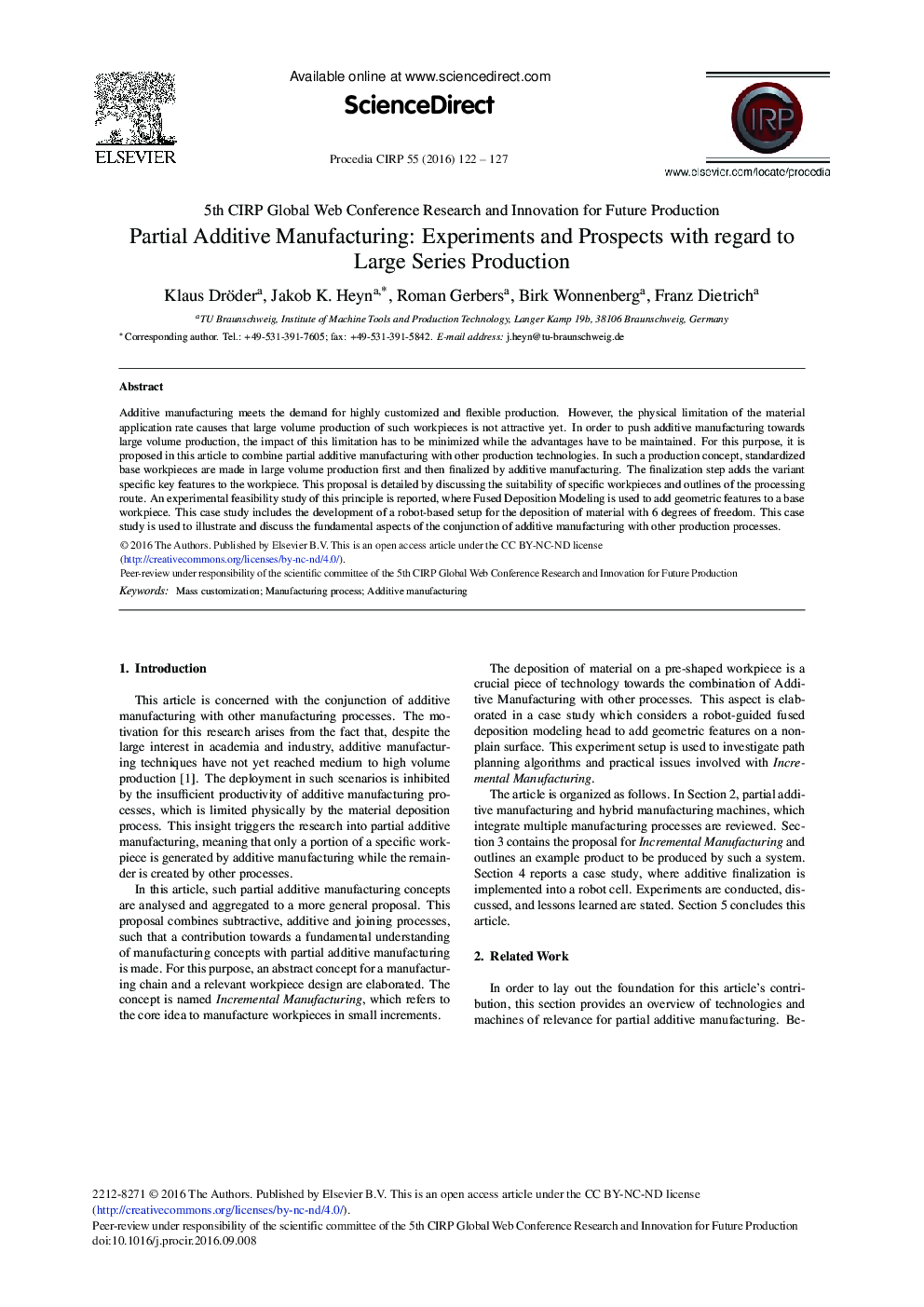| کد مقاله | کد نشریه | سال انتشار | مقاله انگلیسی | نسخه تمام متن |
|---|---|---|---|---|
| 5470028 | 1519297 | 2016 | 6 صفحه PDF | دانلود رایگان |
عنوان انگلیسی مقاله ISI
Partial Additive Manufacturing: Experiments and Prospects with Regard to Large Series Production
ترجمه فارسی عنوان
تولید افزودنی جزئی: آزمایشات و چشم انداز با توجه به تولید سری بزرگ
دانلود مقاله + سفارش ترجمه
دانلود مقاله ISI انگلیسی
رایگان برای ایرانیان
کلمات کلیدی
سفارشی سازی انبوه، فرایند ساخت، تولید افزودنی،
ترجمه چکیده
تولید تکمیلی با تقاضای تولید بسیار انعطاف پذیر و انعطاف پذیر همراه است. با این حال، محدودیت فیزیکی میزان مصرف مواد باعث می شود تولید حجم زیادی از این قطعات هنوز جذاب نباشد. به منظور فشار تولید افزودنی نسبت به حجم تولید بزرگ، تاثیر این محدودیت باید به حداقل برسد در حالی که مزایا باید حفظ شود. برای این منظور، در این مقاله پیشنهاد شده است ترکیب مواد افزودنی جزئی با سایر تکنولوژی های تولیدی ترکیب شود. در چنین مفهومی تولید، قطعات اصلی استاندارد تولید شده در حجم تولید بزرگ و سپس با تولید افزودنی نهایی می شود. مرحله نهایی، ویژگی های کلیدی خاص را به قطعه کار اضافه می کند. این پیشنهاد با بحث درباره مناسب بودن قطعه های خاص و خطوط مسیر پردازش دقیق است. یک مطالعه امکان سنجی تجربی از این اصل گزارش شده است، که در آن از مدل سازی رسوب پراکنده برای اضافه کردن ویژگی های هندسی به یک قطعه پایه استفاده می شود. این مطالعه موردی شامل توسعه روبات مبتنی بر راه اندازی برای رسوب مواد با 6 درجه آزادی است. این مطالعه مورد استفاده برای توضیح و بحث در مورد جنبه های بنیادی ترکیب مواد افزودنی با فرایندهای تولید دیگر است.
موضوعات مرتبط
مهندسی و علوم پایه
سایر رشته های مهندسی
مهندسی صنعتی و تولید
چکیده انگلیسی
Additive manufacturing meets the demand for highly customized and flexible production. However, the physical limitation of the material application rate causes that large volume production of such workpieces is not attractive yet. In order to push additive manufacturing towards large volume production, the impact of this limitation has to be minimized while the advantages have to be maintained. For this purpose, it is proposed in this article to combine partial additive manufacturing with other production technologies. In such a production concept, standardized base workpieces are made in large volume production first and then finalized by additive manufacturing. The finalization step adds the variant specific key features to the workpiece. This proposal is detailed by discussing the suitability of specific workpieces and outlines of the processing route. An experimental feasibility study of this principle is reported, where Fused Deposition Modeling is used to add geometric features to a base workpiece. This case study includes the development of a robot-based setup for the deposition of material with 6 degrees of freedom. This case study is used to illustrate and discuss the fundamental aspects of the conjunction of additive manufacturing with other production processes.
ناشر
Database: Elsevier - ScienceDirect (ساینس دایرکت)
Journal: Procedia CIRP - Volume 55, 2016, Pages 122-127
Journal: Procedia CIRP - Volume 55, 2016, Pages 122-127
نویسندگان
Klaus Dröder, Jakob K. Heyn, Roman Gerbers, Birk Wonnenberg, Franz Dietrich,
